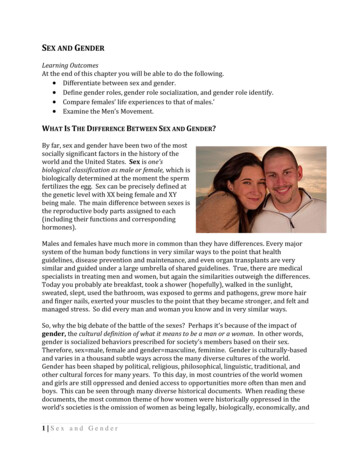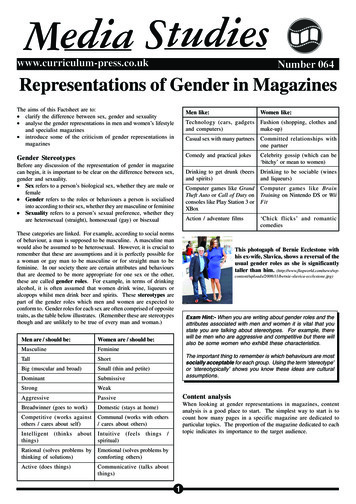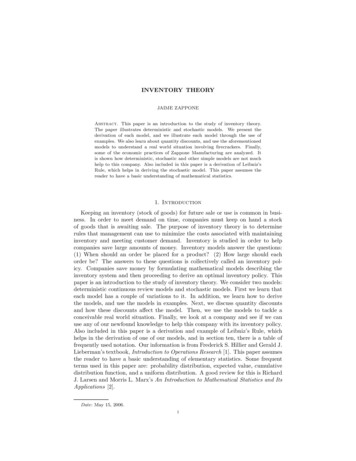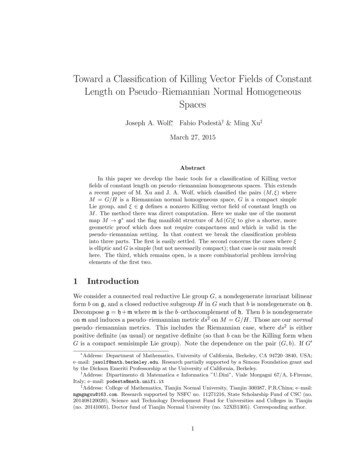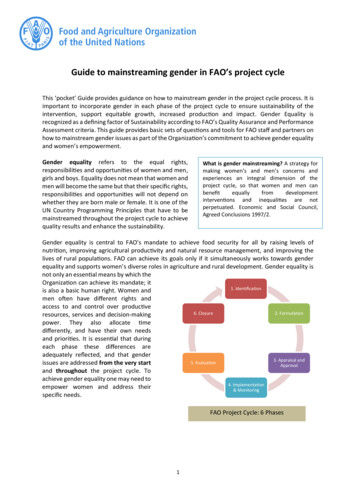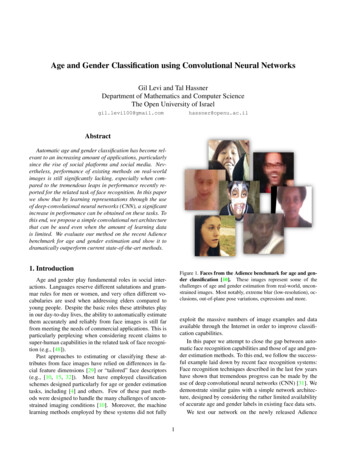
Transcription
Age and Gender Classification using Convolutional Neural NetworksGil Levi and Tal HassnerDepartment of Mathematics and Computer ScienceThe Open University of ractAutomatic age and gender classification has become relevant to an increasing amount of applications, particularlysince the rise of social platforms and social media. Nevertheless, performance of existing methods on real-worldimages is still significantly lacking, especially when compared to the tremendous leaps in performance recently reported for the related task of face recognition. In this paperwe show that by learning representations through the useof deep-convolutional neural networks (CNN), a significantincrease in performance can be obtained on these tasks. Tothis end, we propose a simple convolutional net architecturethat can be used even when the amount of learning datais limited. We evaluate our method on the recent Adiencebenchmark for age and gender estimation and show it todramatically outperform current state-of-the-art methods.1. IntroductionFigure 1. Faces from the Adience benchmark for age and gender classification [10]. These images represent some of thechallenges of age and gender estimation from real-world, unconstrained images. Most notably, extreme blur (low-resolution), occlusions, out-of-plane pose variations, expressions and more.Age and gender play fundamental roles in social interactions. Languages reserve different salutations and grammar rules for men or women, and very often different vocabularies are used when addressing elders compared toyoung people. Despite the basic roles these attributes playin our day-to-day lives, the ability to automatically estimatethem accurately and reliably from face images is still farfrom meeting the needs of commercial applications. This isparticularly perplexing when considering recent claims tosuper-human capabilities in the related task of face recognition (e.g., [48]).Past approaches to estimating or classifying these attributes from face images have relied on differences in facial feature dimensions [29] or “tailored” face descriptors(e.g., [10, 15, 32]). Most have employed classificationschemes designed particularly for age or gender estimationtasks, including [4] and others. Few of these past methods were designed to handle the many challenges of unconstrained imaging conditions [10]. Moreover, the machinelearning methods employed by these systems did not fullyexploit the massive numbers of image examples and dataavailable through the Internet in order to improve classification capabilities.In this paper we attempt to close the gap between automatic face recognition capabilities and those of age and gender estimation methods. To this end, we follow the successful example laid down by recent face recognition systems:Face recognition techniques described in the last few yearshave shown that tremendous progress can be made by theuse of deep convolutional neural networks (CNN) [31]. Wedemonstrate similar gains with a simple network architecture, designed by considering the rather limited availabilityof accurate age and gender labels in existing face data sets.We test our network on the newly released Adience1
benchmark for age and gender classification of unfilteredface images [10]. We show that despite the very challengingnature of the images in the Adience set and the simplicity ofour network design, our method outperforms existing stateof the art by substantial margins. Although these resultsprovide a remarkable baseline for deep-learning-based approaches, they leave room for improvements by more elaborate system designs, suggesting that the problem of accurately estimating age and gender in the unconstrained settings, as reflected by the Adience images, remains unsolved.In order to provide a foothold for the development of moreeffective future methods, we make our trained models andclassification system publicly available. For more information, please see the project webpage www.openu.ac.il/home/hassner/projects/cnn agegender.2. Related WorkBefore describing the proposed method we briefly review related methods for age and gender classification andprovide a cursory overview of deep convolutional networks.2.1. Age and Gender ClassificationAge classification. The problem of automatically extracting age related attributes from facial images has receivedincreasing attention in recent years and many methods havebeen put fourth. A detailed survey of such methods can befound in [11] and, more recently, in [21]. We note that despite our focus here on age group classification rather thanprecise age estimation (i.e., age regression), the survey below includes methods designed for either task.Early methods for age estimation are based on calculating ratios between different measurements of facial features [29]. Once facial features (e.g. eyes, nose, mouth,chin, etc.) are localized and their sizes and distances measured, ratios between them are calculated and used for classifying the face into different age categories according tohand-crafted rules. More recently, [41] uses a similar approach to model age progression in subjects under 18 yearsold. As those methods require accurate localization of facialfeatures, a challenging problem by itself, they are unsuitable for in-the-wild images which one may expect to findon social platforms.On a different line of work are methods that representthe aging process as a subspace [16] or a manifold [19]. Adrawback of those methods is that they require input images to be near-frontal and well-aligned. These methodstherefore present experimental results only on constraineddata-sets of near-frontal images (e.g UIUC-IFP-Y [12, 19],FG-NET [30] and MORPH [43]). Again, as a consequence,such methods are ill-suited for unconstrained images.Different from those described above are methods thatuse local features for representing face images. In [55]Gaussian Mixture Models (GMM) [13] were used to represent the distribution of facial patches. In [54] GMM wereused again for representing the distribution of local facialmeasurements, but robust descriptors were used instead ofpixel patches. Finally, instead of GMM, Hidden-MarkovModel, super-vectors [40] were used in [56] for representing face patch distributions.An alternative to the local image intensity patches are robust image descriptors: Gabor image descriptors [32] wereused in [15] along with a Fuzzy-LDA classifier which considers a face image as belonging to more than one ageclass. In [20] a combination of Biologically-Inspired Features (BIF) [44] and various manifold-learning methodswere used for age estimation. Gabor [32] and local binarypatterns (LBP) [1] features were used in [7] along with ahierarchical age classifier composed of Support Vector Machines (SVM) [9] to classify the input image to an age-classfollowed by a support vector regression [52] to estimate aprecise age.Finally, [4] proposed improved versions of relevant component analysis [3] and locally preserving projections [36].Those methods are used for distance learning and dimensionality reduction, respectively, with Active AppearanceModels [8] as an image feature.All of these methods have proven effective on smalland/or constrained benchmarks for age estimation. To ourknowledge, the best performing methods were demonstrated on the Group Photos benchmark [14]. In [10]state-of-the-art performance on this benchmark was presented by employing LBP descriptor variations [53] and adropout-SVM classifier. We show our proposed method tooutperform the results they report on the more challengingAdience benchmark, designed for the same task.Gender classification. A detailed survey of gender classification methods can be found in [34] and more recentlyin [42]. Here we quickly survey relevant methods.One of the early methods for gender classification [17]used a neural network trained on a small set of near-frontalface images. In [37] the combined 3D structure of thehead (obtained using a laser scanner) and image intensities were used for classifying gender. SVM classifierswere used by [35], applied directly to image intensities.Rather than using SVM, [2] used AdaBoost for the samepurpose, here again, applied to image intensities. Finally,viewpoint-invariant age and gender classification was presented by [49].More recently, [51] used the Webers Local texture Descriptor [6] for gender recognition, demonstrating nearperfect performance on the FERET benchmark [39].In [38], intensity, shape and texture features were used withmutual information, again obtaining near-perfect results onthe FERET benchmark.
Figure 2. Illustration of our CNN architecture. The network contains three convolutional layers, each followed by a rectified linearoperation and pooling layer. The first two layers also follow normalization using local response normalization [28]. The first ConvolutionalLayer contains 96 filters of 7 7 pixels, the second Convolutional Layer contains 256 filters of 5 5 pixels, The third and final ConvolutionalLayer contains 384 filters of 3 3 pixels. Finally, two fully-connected layers are added, each containing 512 neurons. See Figure 3 for adetailed schematic view and the text for more information.Most of the methods discussed above used the FERETbenchmark [39] both to develop the proposed systems andto evaluate performances. FERET images were taken under highly controlled condition and are therefore much lesschallenging than in-the-wild face images. Moreover, theresults obtained on this benchmark suggest that it is saturated and not challenging for modern methods. It is therefore difficult to estimate the actual relative benefit of thesetechniques. As a consequence, [46] experimented on thepopular Labeled Faces in the Wild (LFW) [25] benchmark,primarily used for face recognition. Their method is a combination of LBP features with an AdaBoost classifier.As with age estimation, here too, we focus on the Adience set which contains images more challenging than thoseprovided by LFW, reporting performance using a more robust system, designed to better exploit information frommassive example training sets.2.2. Deep convolutional neural networksOne of the first applications of convolutional neural networks (CNN) is perhaps the LeNet-5 network describedby [31] for optical character recognition. Compared to modern deep CNN, their network was relatively modest due tothe limited computational resources of the time and the algorithmic challenges of training bigger networks.Though much potential laid in deeper CNN architectures(networks with more neuron layers), only recently havethey became prevalent, following the dramatic increase inboth the computational power (due to Graphical Processing Units), the amount of training data readily available onthe Internet, and the development of more effective methodsfor training such complex models. One recent and notableexamples is the use of deep CNN for image classificationon the challenging Imagenet benchmark [28]. Deep CNNhave additionally been successfully applied to applicationsincluding human pose estimation [50], face parsing [33],facial keypoint detection [47], speech recognition [18] andaction classification [27]. To our knowledge, this is the firstreport of their application to the tasks of age and genderclassification from unconstrained photos.3. A CNN for age and gender estimationGathering a large, labeled image training set for age andgender estimation from social image repositories requireseither access to personal information on the subjects appearing in the images (their birth date and gender), whichis often private, or is tedious and time-consuming to manually label. Data-sets for age and gender estimation fromreal-world social images are therefore relatively limited insize and presently no match in size with the much larger image classification data-sets (e.g. the Imagenet dataset [45]).Overfitting is common problem when machine learningbased methods are used on such small image collections.This problem is exacerbated when considering deep convolutional neural networks due to their huge numbers of modelparameters. Care must therefore be taken in order to avoidoverfitting under such circumstances.3.1. Network architectureOur proposed network architecture is used throughoutour experiments for both age and gender classification. It isillustrated in Figure 2. A more detailed, schematic diagramof the entire network design is additionally provided in Figure 3. The network comprises of only three convolutionallayers and two fully-connected layers with a small numberof neurons. This, by comparison to the much larger architectures applied, for example, in [28] and [5]. Our choiceof a smaller network design is motivated both from our desire to reduce the risk of overfitting as well as the nature
for face recognition in [48].All three color channels are processed directly by thenetwork. Images are first rescaled to 256 256 and a cropof 227 227 is fed to the network. The three subsequentconvolutional layers are then defined as follows.1. 96 filters of size 3 7 7 pixels are applied to the inputin the first convolutional layer, followed by a rectifiedlinear operator (ReLU), a max pooling layer taking themaximal value of 3 3 regions with two-pixel stridesand a local response normalization layer [28].2. The 96 28 28 output of the previous layer is thenprocessed by the second convolutional layer, containing 256 filters of size 96 5 5 pixels. Again, thisis followed by ReLU, a max pooling layer and a local response normalization layer with the same hyperparameters as before.3. Finally, the third and last convolutional layer operateson the 256 14 14 blob by applying a set of 384filters of size 256 3 3 pixels, followed by ReLUand a max pooling layer.The following fully connected layers are then defined by:4. A first fully connected layer that receives the output ofthe third convolutional layer and contains 512 neurons,followed by a ReLU and a dropout layer.5. A second fully connected layer that receives the 512dimensional output of the first fully connected layerand again contains 512 neurons, followed by a ReLUand a dropout layer.6. A third, fully connected layer which maps to the finalclasses for age or gender.Finally, the output of the last fully connected layer is fedto a soft-max layer that assigns a probability for each class.The prediction itself is made by taking the class with themaximal probability for the given test image.3.2. Testing and trainingFigure 3. Full schematic diagram of our network architecture.Please see text for more details.of the problems we are attempting to solve: age classification on the Adience set requires distinguishing betweeneight classes; gender only two. This, compared to, e.g., theten thousand identity classes used to train the network usedInitialization. The weights in all layers are initialized withrandom values from a zero mean Gaussian with standarddeviation of 0.01. To stress this, we do not use pre-trainedmodels for initializing the network; the network is trained,from scratch, without using any data outside of the imagesand the labels available by the benchmark. This, again,should be compared with CNN implementations used forface recognition, where hundreds of thousands of imagesare used for training [48].Target values for training are represented as sparse, binary vectors corresponding to the ground truth classes. Foreach training image, the target, label vector is in the length
of the number of classes (two for gender, eight for the eightage classes of the age classification task), containing 1 inthe index of the ground truth and 0 elsewhere.Network training. Aside from our use of a lean networkarchitecture, we apply two additional methods to furtherlimit the risk of overfitting. First we apply dropout learning [24] (i.e. randomly setting the output value of network neurons to zero). The network includes two dropoutlayers with a dropout ratio of 0.5 (50% chance of settinga neuron’s output value to zero). Second, we use dataaugmentation by taking a random crop of 227 227 pixelsfrom the 256 256 input image and randomly mirror it ineach forward-backward training pass. This, similarly to themultiple crop and mirror variations used by [48].Training itself is performed using stochastic gradientdecent with image batch size of fifty images. The initial learning rate is e 3, reduced to e 4 after 10K iterations.Prediction. We experimented with two methods of usingthe network in order to produce age and gender predictionsfor novel faces: Center Crop: Feeding the network with the face image, cropped to 227 227 around the face center. Over-sampling: We extract five 227 227 pixel cropregions, four from the corners of the 256 256 faceimage, and an additional crop region from the centerof the face. The network is presented with all five images, along with their horizontal reflections. Its finalprediction is taken to be the average prediction valueacross all these variations.We have found that small misalignments in the Adience images, caused by the many challenges of these images (occlusions, motion blur, etc.) can have a noticeable impacton the quality of our results. This second, over-samplingmethod, is designed to compensate for these small misalignments, bypassing the need for improving alignment quality,but rather directly feeding the network with multiple translated versions of the same face.4. ExperimentsOur method is implemented using the Caffe open-sourceframework [26]. Training was performed on an AmazonGPU machine with 1,536 CUDA cores and 4GB of videomemory. Training each network required about four hours,predicting age or gender on a single image using our network requires about 200ms. Prediction running times canconceivably be substantially improved by running the network on image batches.4.1. The Adience benchmarkWe test the accuracy of our CNN design using the recently released Adience benchmark [10], designed for ageand gender classification. The Adience set consists of images automatically uploaded to Flickr from smart-phone devices. Because these images were uploaded without priormanual filtering, as is typically the case on media webpages (e.g., images from the LFW collection [25]) or socialwebsites (the Group Photos set [14]), viewing conditions inthese images are highly unconstrained, reflecting many ofthe real-world challenges of faces appearing in Internet images. Adience images therefore capture extreme variationsin head pose, lightning conditions quality, and more.The entire Adience collection includes roughly 26K images of 2,284 subjects. Table 1 lists the breakdown ofthe collection into the different age categories. Testing forboth age or gender classification is performed using a standard five-fold, subject-exclusive cross-validation protocol,defined in [10]. We use the in-plane aligned version ofthe faces, originally used in [10]. These images are usedrater than newer alignment techniques in order to highlightthe performance gain attributed to the network architecture,rather than better preprocessing.We emphasize that the same network architecture is usedfor all test folds of the benchmark and in fact, for both gender and age classification tasks. This is performed in orderto ensure the validity of our results across folds, but also todemonstrate the generality of the network design proposedhere; the same architecture performs well across different,related problems.We compare previously reported results to the resultscomputed by our network. Our results include both methods for testing: center-crop and over-sampling (Section 3).4.2. ResultsTable 2 and Table 3 presents our results for gender andage classification respectively. Table 4 further provides aconfusion matrix for our multi-class age classification results. For age classification, we measure and compare boththe accuracy when the algorithm gives the exact age-groupclassification and when the algorithm is off by one adjacent age-group (i.e., the subject belongs to the group immediately older or immediately younger than the predictedgroup). This follows others who have done so in the past,and reflects the uncertainty inherent to the task – facial features often change very little between oldest faces in oneage class and the youngest faces of the subsequent class.Both tables compare performance with the methodsdescribed in [10]. Table 2 also provides a comparisonwith [23] which used the same gender classification pipelineof [10] applied to more effective alignment of the faces;faces in their tests were synthetically modified to appearfacing forward.
Figure 4. Gender misclassifications. Top row: Female subjects mistakenly classified as males. Bottom row: Male subjects mistakenlyclassified as femalesFigure 5. Age misclassifications. Top row: Older subjects mistakenly classified as younger. Bottom row: Younger subjects mistakenlyclassified as older.0-2 4-6 8-13Male745 928 934Female 682 1234 1360Both 1427 2162 e 1. The AdienceFaces benchmark. Breakdown of the AdienceFaces benchmark into the different Age and Gender classes.Evidently, the proposed method outperforms the reported state-of-the-art on both tasks with considerable gaps.Also evident is the contribution of the over-sampling approach, which provides an additional performance boostover the original network. This implies that better alignment (e.g., frontalization [22, 23]) may provide an additional boost in performance.We provide a few examples of both gender and age misclassifications in Figures 4 and 5, respectively. These showthat many of the mistakes made by our system are due to extremely challenging viewing conditions of some of the Adience benchmark images. Most notable are mistakes causedby blur or low resolution and occlusions (particularly fromheavy makeup). Gender estimation mistakes also frequentlyoccur for images of babies or very young children whereobvious gender attributes are not yet visible.MethodBest from [10]Best from [23]Proposed using single cropProposed using over-sampleAccuracy77.8 1.379.3 0.085.9 1.486.8 1.4Table 2. Gender estimation results on the Adience benchmark.Listed are the mean accuracy standard error over all age categories. Best results are marked in bold.MethodBest from [10]Proposed using single cropProposed using over-sampleExact45.1 2.649.5 4.450.7 5.11-off79.5 1.484.6 1.784.7 2.2Table 3. Age estimation results on the Adience benchmark.Listed are the mean accuracy standard error over all age categories. Best results are marked in bold.5. ConclusionsThough many previous methods have addressed theproblems of age and gender classification, until recently,much of this work has focused on constrained images takenin lab settings. Such settings do not adequately reflect appearance variations common to the real-world images in social websites and online repositories. Internet images, however, are not simply more challenging: they are also abun-
0.0050.0610.0280.1080.2680.1650.357Table 4. Age estimation confusion matrix on the Adiencebenchmark.[2][3][4][5]dant. The easy availability of huge image collections provides modern machine learning based systems with effectively endless training data, though this data is not alwayssuitably labeled for supervised learning.Taking example from the related problem of face recognition we explore how well deep CNN perform on thesetasks using Internet data. We provide results with a leandeep-learning architecture designed to avoid overfitting dueto the limitation of limited labeled data. Our network is“shallow” compared to some of the recent network architectures, thereby reducing the number of its parameters andthe chance for overfitting. We further inflate the size of thetraining data by artificially adding cropped versions of theimages in our training set. The resulting system was testedon the Adience benchmark of unfiltered images and shownto significantly outperform recent state of the art.Two important conclusions can be made from our results.First, CNN can be used to provide improved age and gender classification results, even considering the much smallersize of contemporary unconstrained image sets labeled forage and gender. Second, the simplicity of our model implies that more elaborate systems using more training datamay well be capable of substantially improving results beyond those reported ts[15]This research is based upon work supported in part bythe Office of the Director of National Intelligence (ODNI),Intelligence Advanced Research Projects Activity (IARPA),via IARPA 2014-14071600010. The views and conclusionscontained herein are those of the authors and should notbe interpreted as necessarily representing the official policies or endorsements, either expressed or implied, of ODNI,IARPA, or the U.S. Government. The U.S. Government isauthorized to reproduce and distribute reprints for Governmental purpose notwithstanding any copyright annotationthereon.[17]References[19][1] T. Ahonen, A. Hadid, and M. Pietikainen. Face descriptionwith local binary patterns: Application to face recognition.[16][18]Trans. Pattern Anal. Mach. Intell., 28(12):2037–2041, 2006.2S. Baluja and H. A. Rowley. Boosting sex identification performance. Int. J. Comput. Vision, 71(1):111–119, 2007. 2A. Bar-Hillel, T. Hertz, N. Shental, and D. Weinshall. Learning distance functions using equivalence relations. In Int.Conf. Mach. Learning, volume 3, pages 11–18, 2003. 2W.-L. Chao, J.-Z. Liu, and J.-J. Ding. Facial age estimation based on label-sensitive learning and age-oriented regression. Pattern Recognition, 46(3):628–641, 2013. 1, 2K. Chatfield, K. Simonyan, A. Vedaldi, and A. Zisserman.Return of the devil in the details: Delving deep into convolutional nets. arXiv preprint arXiv:1405.3531, 2014. 3J. Chen, S. Shan, C. He, G. Zhao, M. Pietikainen, X. Chen,and W. Gao. Wld: A robust local image descriptor. Trans.Pattern Anal. Mach. Intell., 32(9):1705–1720, 2010. 2S. E. Choi, Y. J. Lee, S. J. Lee, K. R. Park, and J. Kim. Ageestimation using a hierarchical classifier based on global andlocal facial features. Pattern Recognition, 44(6):1262–1281,2011. 2T. F. Cootes, G. J. Edwards, and C. J. Taylor. Active appearance models. In European Conf. Comput. Vision, pages484–498. Springer, 1998. 2C. Cortes and V. Vapnik. Support-vector networks. Machinelearning, 20(3):273–297, 1995. 2E. Eidinger, R. Enbar, and T. Hassner. Age and gender estimation of unfiltered faces. Trans. on Inform. Forensics andSecurity, 9(12), 2014. 1, 2, 5, 6Y. Fu, G. Guo, and T. S. Huang. Age synthesis and estimation via faces: A survey. Trans. Pattern Anal. Mach. Intell.,32(11):1955–1976, 2010. 2Y. Fu and T. S. Huang. Human age estimation with regression on discriminative aging manifold. Int. Conf. Multimedia, 10(4):578–584, 2008. 2K. Fukunaga. Introduction to statistical pattern recognition.Academic press, 1991. 2A. C. Gallagher and T. Chen. Understanding images ofgroups of people. In Proc. Conf. Comput. Vision PatternRecognition, pages 256–263. IEEE, 2009. 2, 5F. Gao and H. Ai. Face age classification on consumer images with gabor feature and fuzzy lda method. In Advancesin biometrics, pages 132–141. Springer, 2009. 1, 2X. Geng, Z.-H. Zhou, and K. Smith-Miles. Automatic ageestimation based on facial aging patterns. Trans. PatternAnal. Mach. Intell., 29(12):2234–2240, 2007. 2B. A. Golomb, D. T. Lawrence, and T. J. Sejnowski. Sexnet:A neural network identifies sex from human faces. In NeuralInform. Process. Syst., pages 572–579, 1990. 2A. Graves, A.-R. Mohamed, and G. Hinton. Speech recognition with deep recurrent neural networks. In Acoustics,Speech and Signal Processing (ICASSP), 2013 IEEE International Conference on, pages 6645–6649. IEEE, 2013. 3G. Guo, Y. Fu, C. R. Dyer, and T. S. Huang. Imagebased human age estimation by manifold learning and locally adjusted robust regression. Trans. Image Processing,17(7):1178–1188, 2008. 2
[20] G. Guo, G. Mu, Y. Fu, C. Dyer, and T. Huang. A study onautomatic age estimation using a large database. In Proc. Int.Conf. Comput. Vision, pages 1986–1991. IEEE, 2009. 2[21] H. Han, C. Otto, and A. K. Jain. Age estimation from faceimages: Human vs. machine performance. In Biometrics(ICB), 2013 International Conference on. IEEE, 2013. 2[22] T. Hassner. Viewing real-world faces in 3d. In Proc. Int.Conf. Comput. Vision, pages 3607–3614. IEEE, 2013. 6[23] T. Hassner, S. Harel, E. Paz, and R. Enbar. Effective facefrontalization in unconstrained images. Proc. Conf. Comput.Vision Pattern Recognition, 2015. 5, 6[24] G. E. Hinton, N. Srivastava, A. Krizhevsky, I. Sutskever, andR. R. Salakhutdinov. Improving neural networks by preventing co-adaptation of feature detectors. arXiv preprintarXiv:1207.0580, 2012. 5[25] G. B. Huang, M. Ramesh, T. Berg, and E. Learned-Miller.Labeled faces in the wild: A database for studying facerecognition in unconstrained environments. Technical report, Technical Report 07-49, University of Massachusetts,Amherst, 2007. 3, 5[26] Y. Jia, E. Shelhamer, J. Donahue, S. Karayev, J. Long, R. Girshick, S. Guadarrama, and T. Darrell. Caffe: Convolutional architecture for fast feature embedding. arXiv preprintarXiv:1408.5093, 2014. 5[27] A. Karpathy, G. Toderici, S. Shetty, T. Leung, R. Sukthankar,and L. Fei-Fei. Large-scale video classification with convolutional neural networks. In Proc. C
Layer contains 96 filters of 7 7pixels, the second Convolutional Layer contains 256 filters of 5 5pixels, The third and final Convolutional Layer contains 384 filters of 3 3 pixels. Finally, two fully-connected layers are added, each containing 512 neurons. See Figure3for a d



